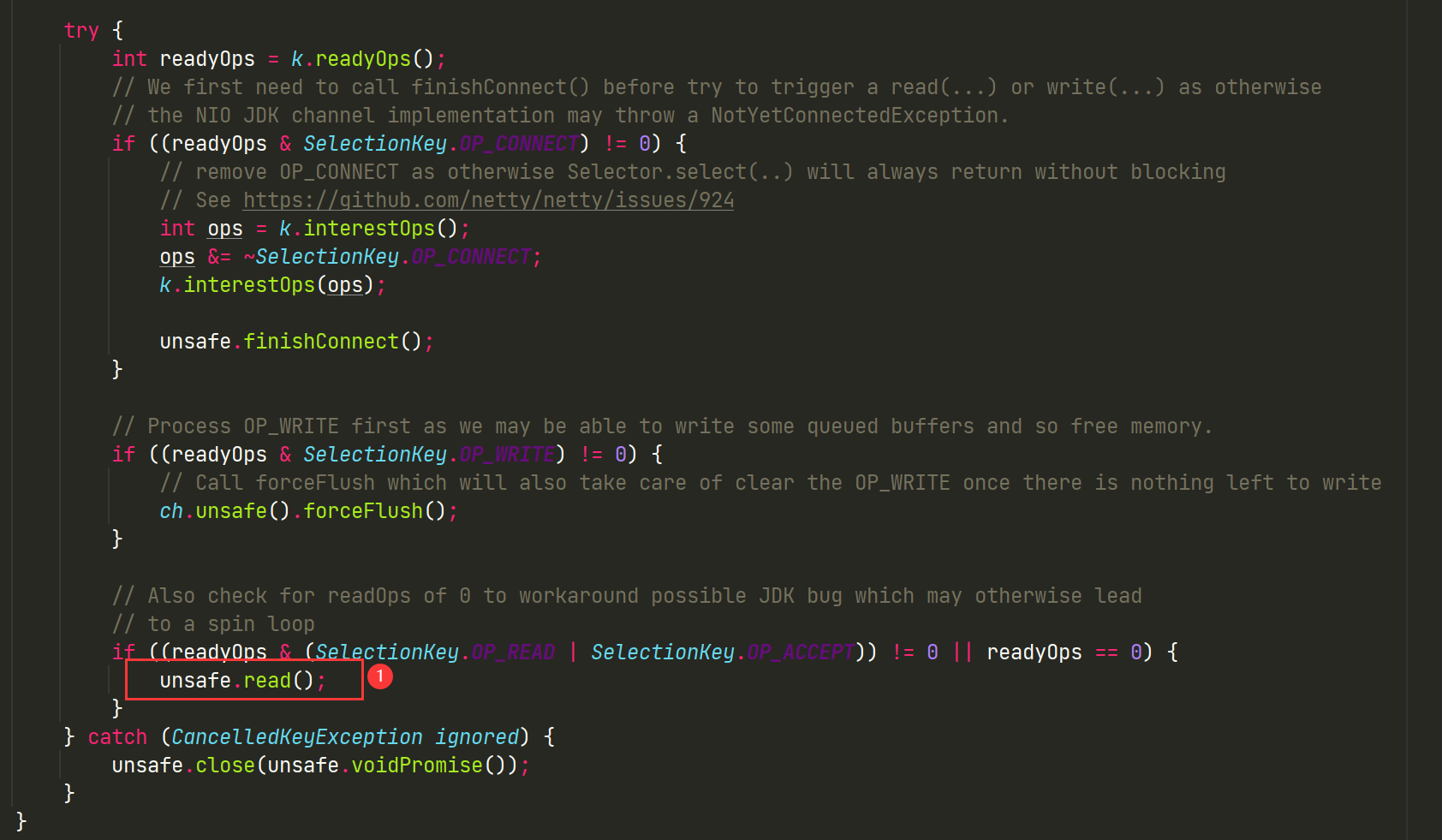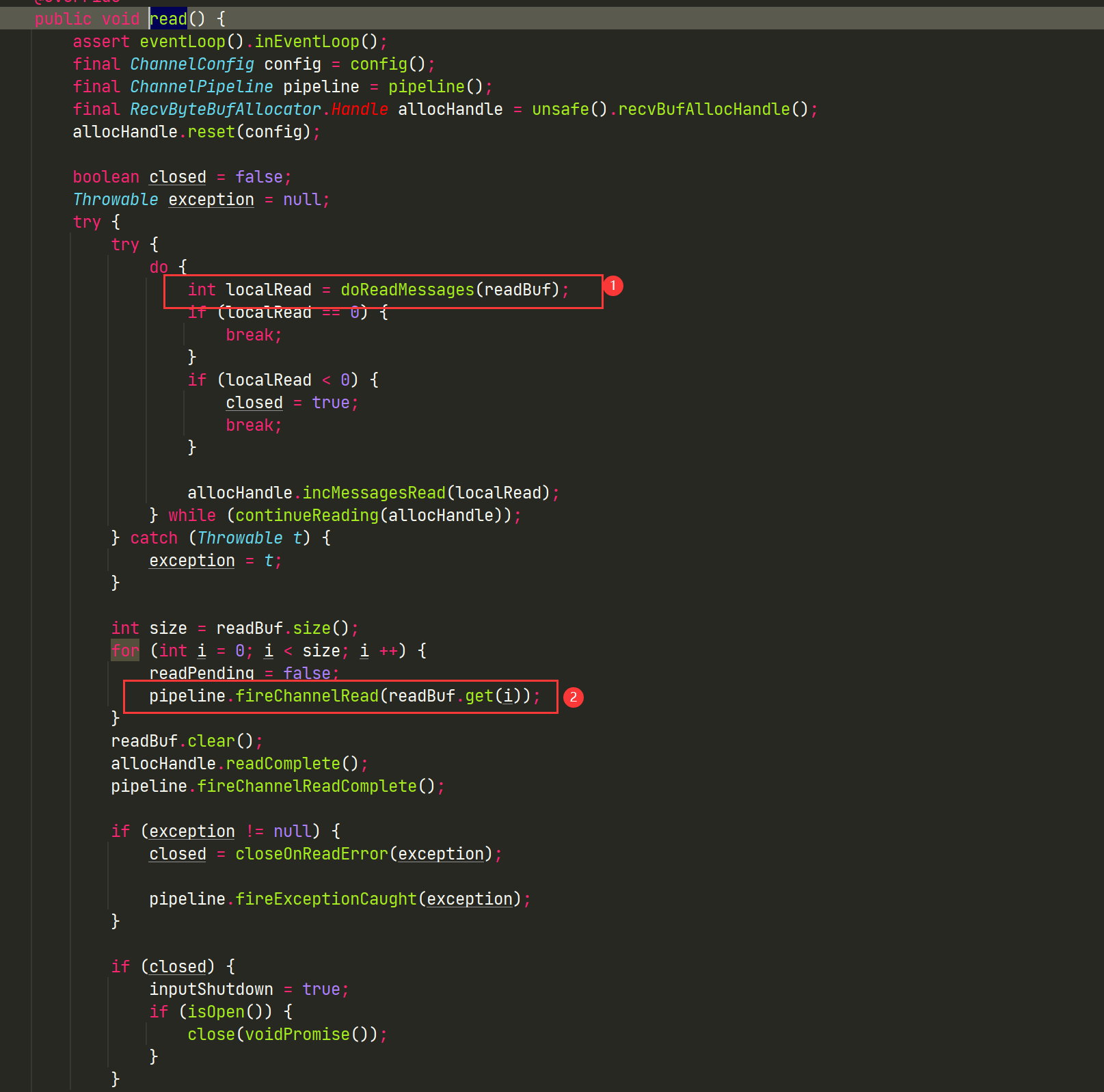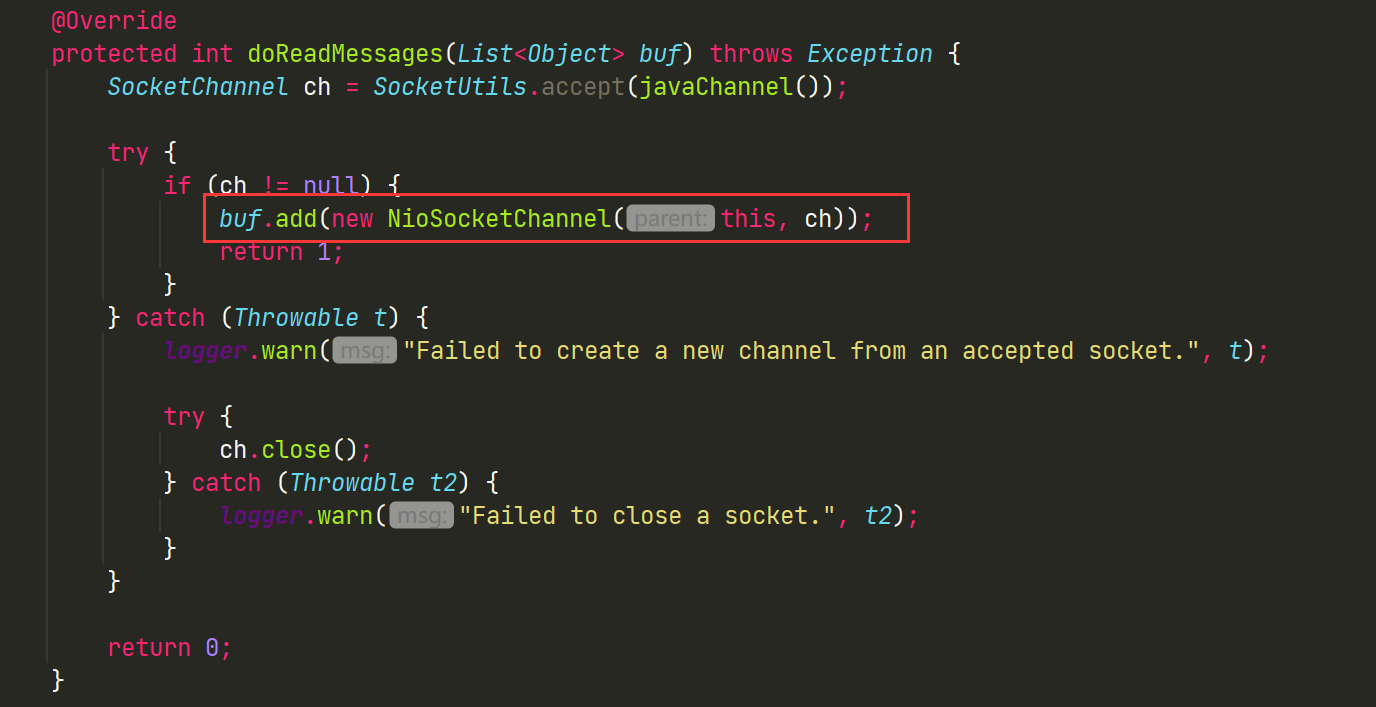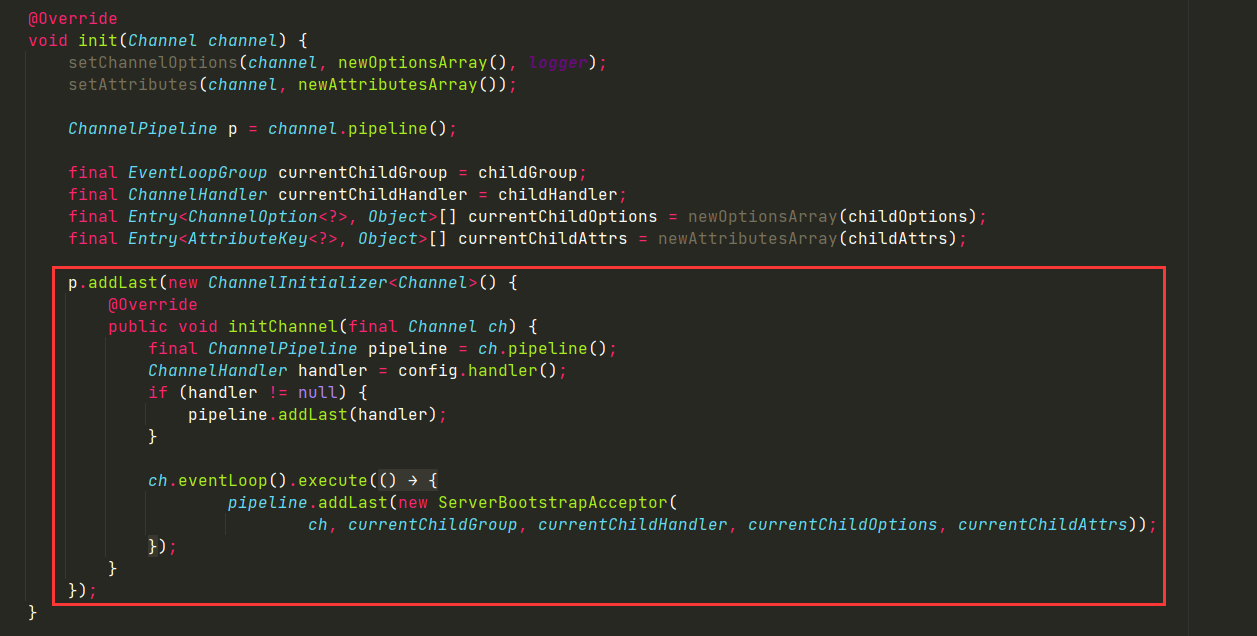Netty源码解析-ChannelInboundHandler#channelRead参数Object对象到底是什么类型
Netty版本:netty-4.1.75.Final
1. 引言
在之前的文章《Netty源码分析-ChannelHandler方法执行顺序和如何工作》中分析了ChannelHandler的方法执行的顺序问题。在这个过程中细心的人可能会发现ChannelInboundHandler#channelRead 方法有个参数是Object:
void channelRead(ChannelHandlerContext ctx, Object msg) throws Exception;
刚刚接触的Netty的开发者肯定也很好奇这个Object到底会是什么类型,今天我们就从源码来分析一下这个Object的类型。了解Object的具体类型同时也可以帮助我们更好的开发。
2. Netty源码分析ChannelInboundHandler#channelRead参数Object类型
这里我们还是以服务器的代码作为例子讲解
package com.github.mxsm.netty.channelhandler;
import com.github.mxsm.netty.DiscardServerHandler;
import io.netty.bootstrap.ServerBootstrap;
import io.netty.channel.ChannelFuture;
import io.netty.channel.ChannelInitializer;
import io.netty.channel.ChannelOption;
import io.netty.channel.EventLoopGroup;
import io.netty.channel.nio.NioEventLoopGroup;
import io.netty.channel.socket.ServerSocketChannel;
import io.netty.channel.socket.SocketChannel;
import io.netty.channel.socket.nio.NioServerSocketChannel;
/**
* @author mxsm
* @date 2022/3/13 10:47
* @Since 1.0.0
*/
public class DiscardServer {
private int port;
public DiscardServer(int port) {
this.port = port;
}
public void run() throws Exception {
EventLoopGroup bossGroup = new NioEventLoopGroup(1); // (1)
EventLoopGroup workerGroup = new NioEventLoopGroup();
try {
ServerBootstrap b = new ServerBootstrap(); // (2)
b.handler(new ChannelInitializer<ServerSocketChannel>(){
@Override
protected void initChannel(ServerSocketChannel ch) throws Exception {
ch.pipeline().addLast(new TimeServerBossOutHandler());
ch.pipeline().addLast(new TimeServerBossInHandler());
}
});
b.group(bossGroup, workerGroup)
.channel(NioServerSocketChannel.class) // (3)
.childHandler(new ChannelInitializer<SocketChannel>() { // (4)
@Override
public void initChannel(SocketChannel ch) throws Exception {
ch.pipeline().addLast(new TimeServerOutHandler());
ch.pipeline().addLast(new TimeServerInHandler());
}
})
.option(ChannelOption.SO_BACKLOG, 128) // (5)
.childOption(ChannelOption.SO_KEEPALIVE, true); // (6)
// Bind and start to accept incoming connections.
ChannelFuture f = b.bind(port).sync(); // (7)
// Wait until the server socket is closed.
// In this example, this does not happen, but you can do that to gracefully
// shut down your server.
f.channel().closeFuture().sync();
} finally {
workerGroup.shutdownGracefully();
bossGroup.shutdownGracefully();
}
}
public static void main(String[] args) throws Exception {
int port = 8080;
if (args.length > 0) {
port = Integer.parseInt(args[0]);
}
new DiscardServer(port).run();
}
}
上面代码改自Netty官网,我这里给BossGroup中的ServerSocketChannel也显示加了ChannelHandler。所以对于ChannelInboundHandler#channelRead参数Object类型我们需要区分是ServerSocketChannel还是SocketChannel。 下面我们也从这两个方面进行源码分析。
Tips: 下面讲的会用到ChannelHandler的方法执行顺序的相关知识,不太清楚的可以查看之前的文章 《Netty源码分析-ChannelHandler方法执行顺序和如何工作》
2.1 ServerSocketChannel中ChannelInboundHandler#channelRead参数Object类型
NioServerSocketChannel创建完成后绑定到BossGroup的EvenLoop上面,往EvenLoop提交任务后,NioEventLoop就开始运行EventLoop#run
@Override
protected void run() {
//省略了大量的代码
for (;;) {
strategy = select(curDeadlineNanos); //select
processSelectedKeys() //处�理SelectedKeys
}
}
上面代码主要看一下processSelectedKeys() 这个方法最终调用的是 NioEventLoop#processSelectedKey(SelectionKey k, AbstractNioChannel ch) 这个方法。这个方法也是ServerSocketChannel的主要处理逻辑:

如上图1位置所示,unsafe.read() 这个方法是解析ChannelInboundHandler#channelRead参数Object类型的关键代码。这个unsafe是怎么来的呢,上面有这样一段代码:

重点:unsafe.read(),调用那个实现取决于具体的实现,NioServerSocketChannel那么调用的就是AbstractNioMessageChannel.NioMessageUnsafe.read :

这个方法重点关注一下上图的标号位置
-
标号1 的位置调用了
AbstractNioMessageChannel#doReadMessages的抽象方法,这个案例下调用的是NioServerSocketChannel#doReadMessages方法:
往
List<Object> buf列表中添加了NioSocketChannel的实例 -
标号2的位置,是触发
ChannelInboundHandler#channelRead,将标号1中添加的NioSocketChannel作为Object的实际对象传入ChannelInboundHandler#channelRead参数Object类型
总结:ServerSocketChannel中ChannelInboundHandler#channelRead参数Object类型是NioSocketChannel
Tips: 使用者可以启动项目进行测试,看一下是不是和上面分析的一样进行验证,上面的关键之处就是在于unsafe.read()这个方法到底是调用哪个实现,同时在触发了ServerSocketChannel的ChannelPipeline后的fireChannelRead如何进行传导到SocketChannel,这个就是我下面要接着分析的。
2.2 ServerSocketChannel中ChannelInboundHandler#channelRead参数Object类型
触发了ServerSocketChannel的ChannelPipeline后的fireChannelRead后,最终调用的是 ServerBootstrap#init 中的如下图框出来��的代码:

ServerBootstrapAcceptor也是一个ChannelInboundHandlerAdapter,同样会触发ChannelInboundHandler#channelRead
Tips: 此时触发的ChannelInboundHandler#channelRead还是属于NioServerSocketChannel

如上图标号1所示此处的Channel实际上是NioSocketChannel实例,也就是NioServerSocketChannel传递过来的。如上图标号2所示这里就是往workGroup中注册NioSocketChannel实例。然后就是workGroup的NioEventLoop就开始运行EventLoop#run,这里的执行和BossGroup中执行的是一样的。唯一不同的就是
unsafe.read() 方法,在NioSocketChannel中是执行AbstractNioByteChannel.NioByteUnsafe#read

如上图标号1所示,这里同样触发了ChannelPipeline#fireChannelRead 这里传入的ChannelInboundHandler#channelRead参数Object类型是ByteBuf的实例。
Tips: 这里的ChannelPipeline#fireChannelRead触发的是NioSocketChannel的。
总结:ServerSocketChannel中ChannelInboundHandler#channelRead参数Object类型是ByteBuf
Tips: 如果经过解码器后,触发的后续的ChannelInboundHandler#channelRead参数Object的类型就是解码后的消息类型
3. 总结
ChannelInboundHandler#channelRead参数Object类型取决于是ServerSocketChannel还是SocketChannel。
- ServerSocketChannel中ChannelInboundHandler#channelRead参数Object类型是NioSocketChannel
- ServerSocketChannel中ChannelInboundHandler#channelRead参数Object类型是ByteBuf
- 对于Netty的解码器只是对ChannelInboundHandler进行拓展
我是蚂蚁背大象,文章对你有帮助点赞关注我,文章有不正确的地方请您斧正留言评论~谢谢